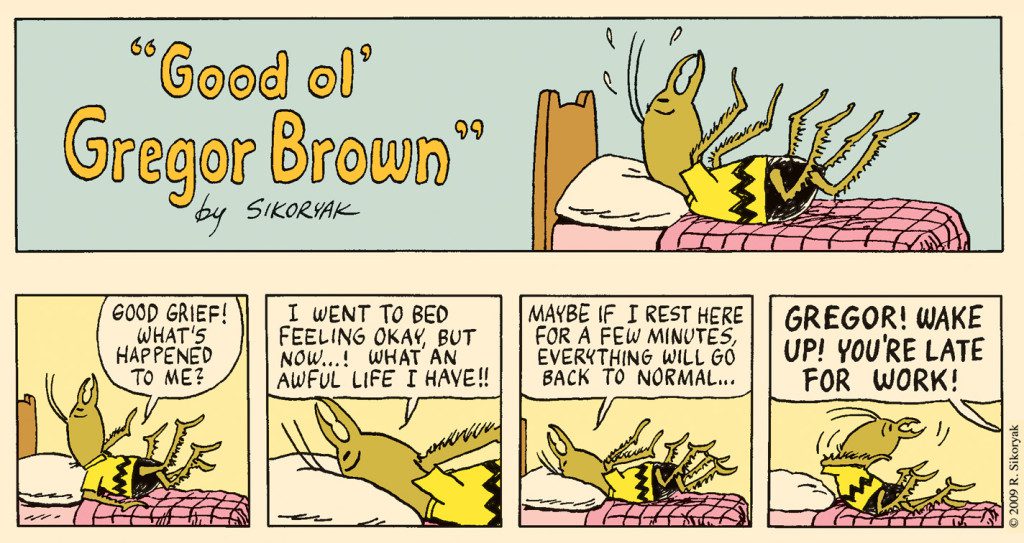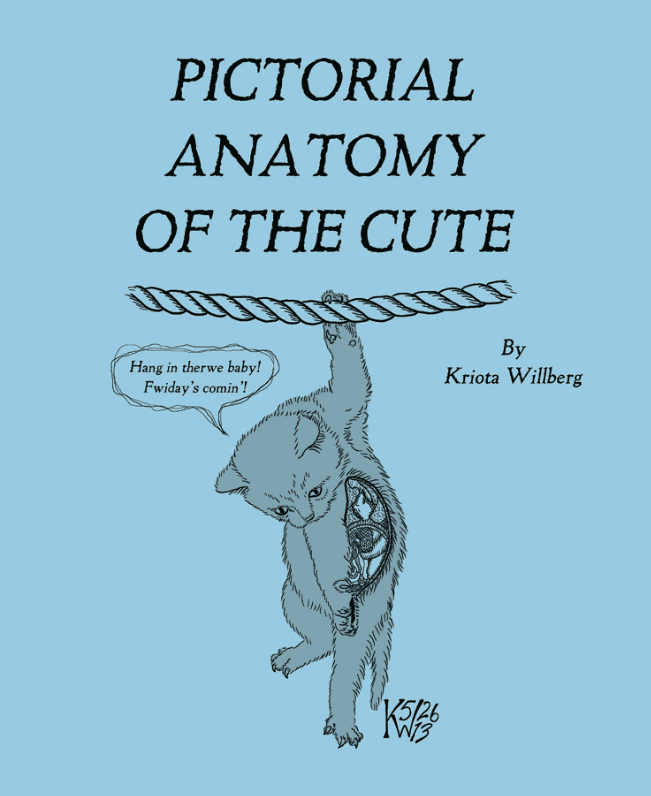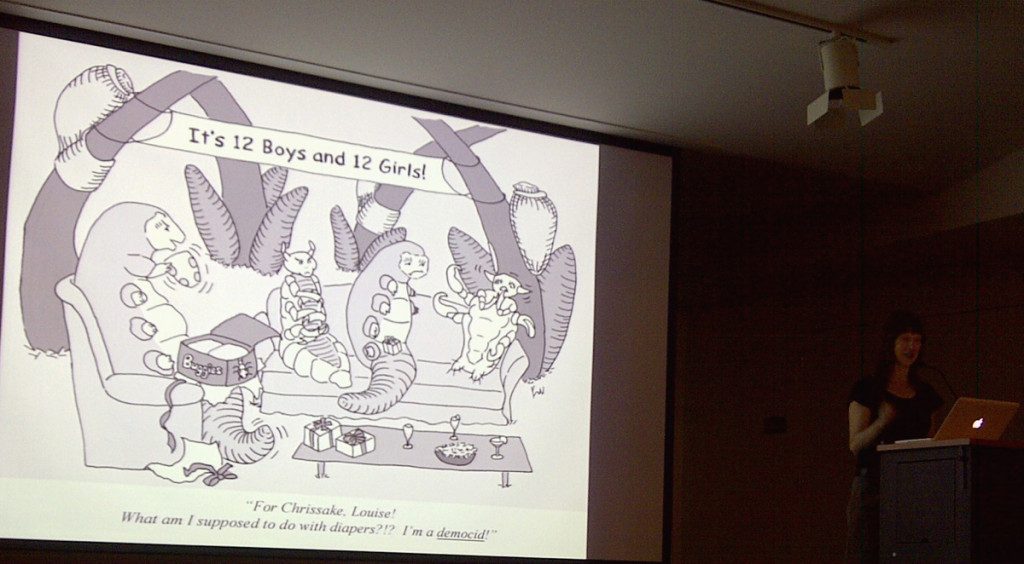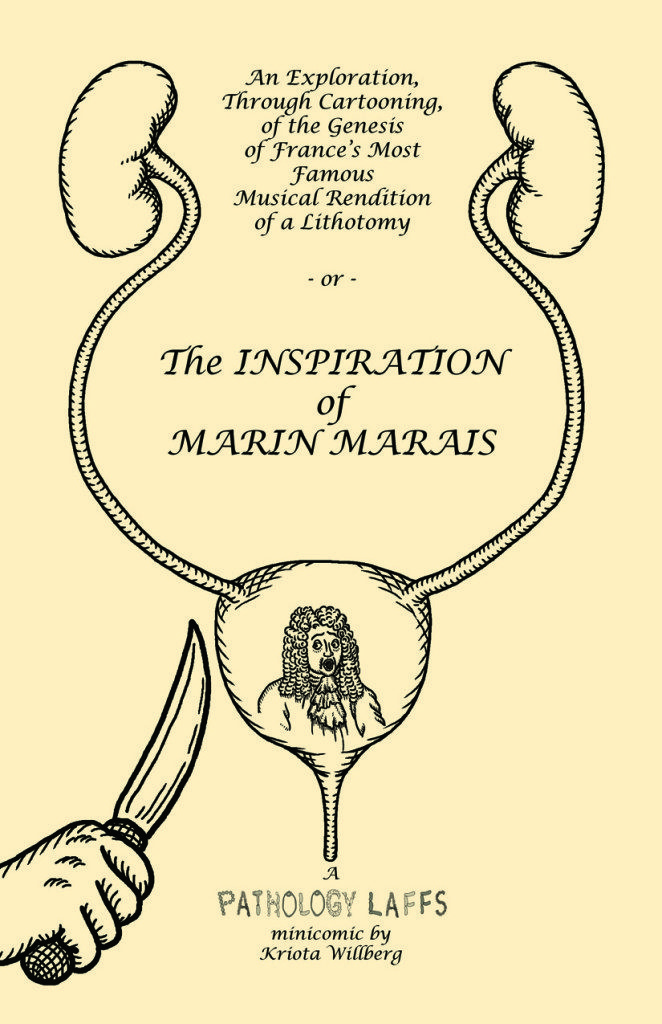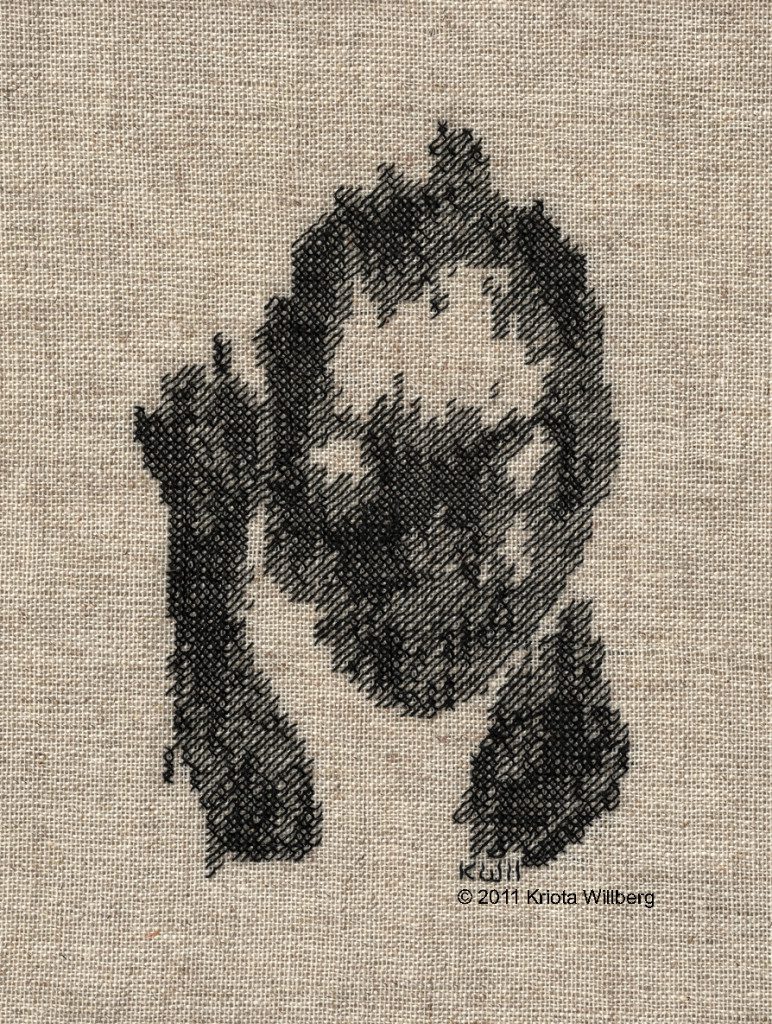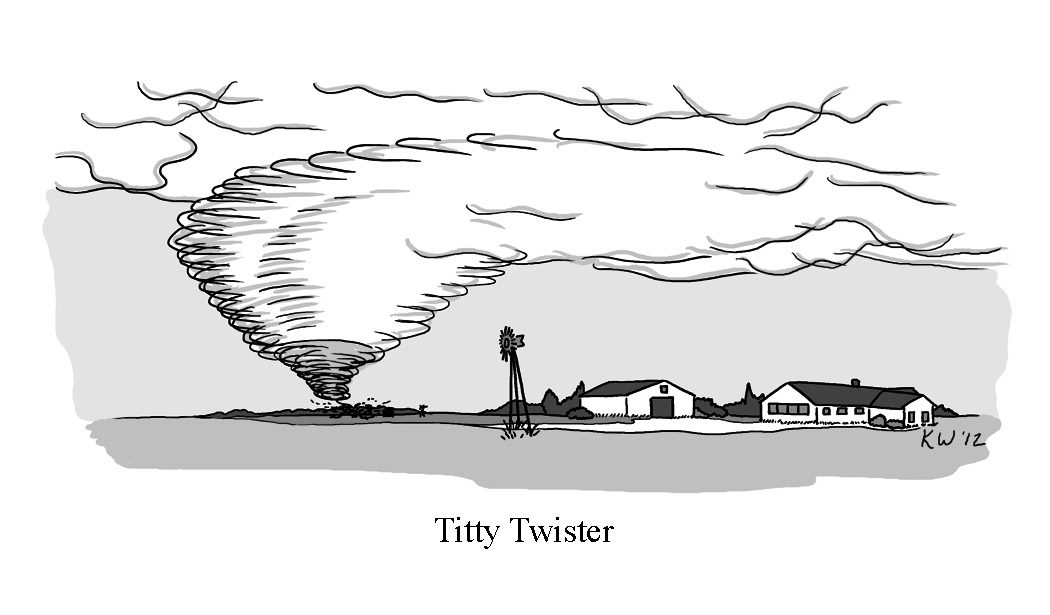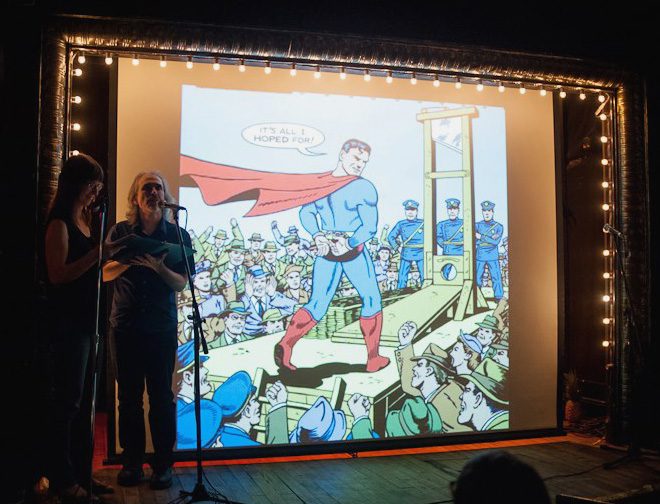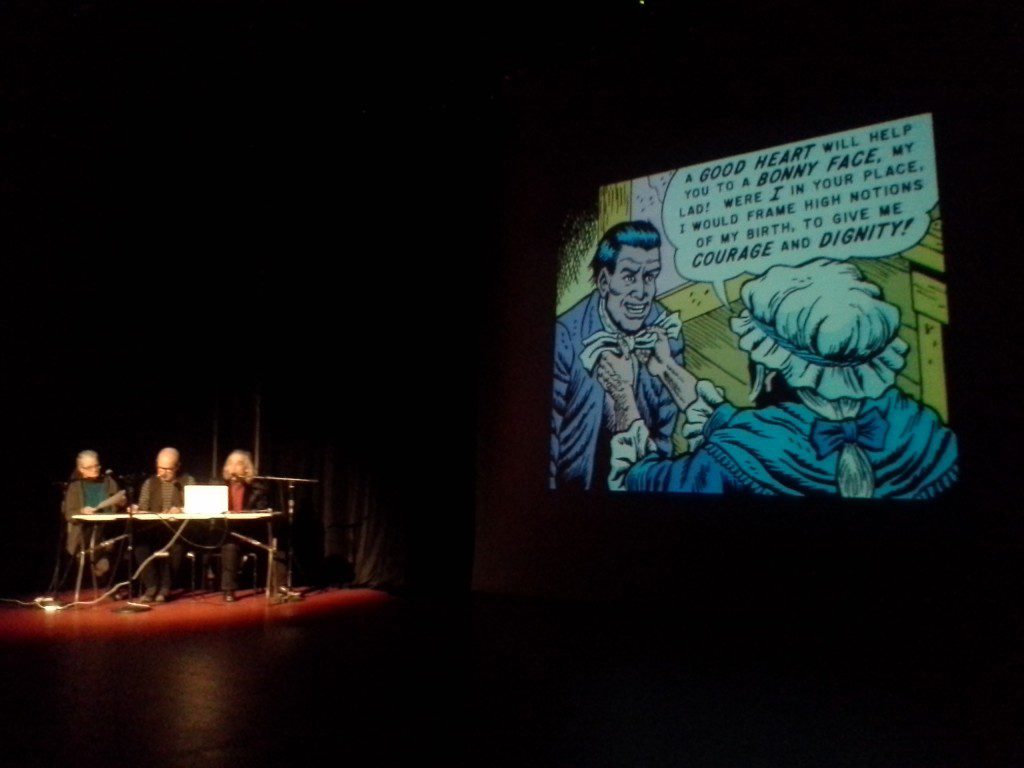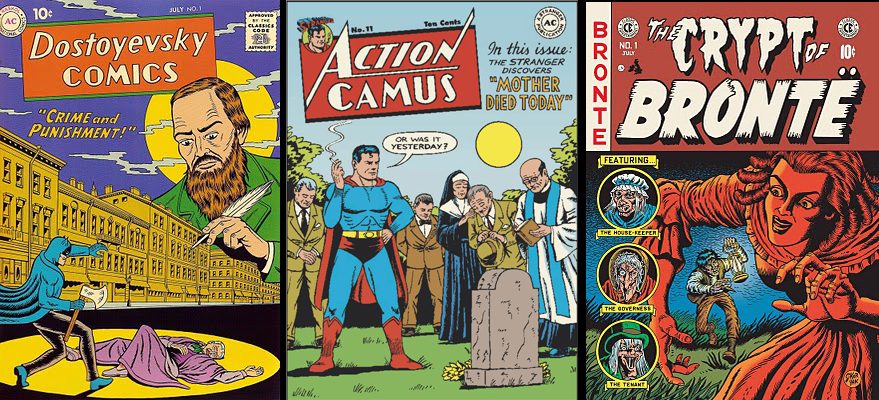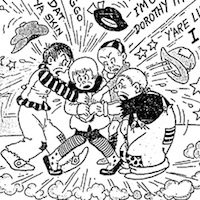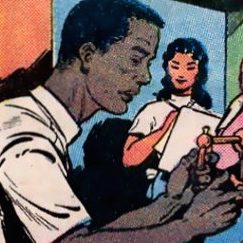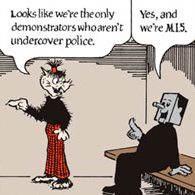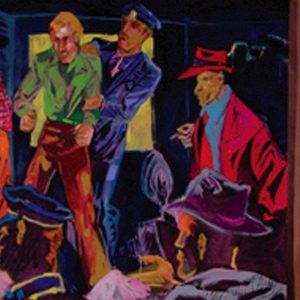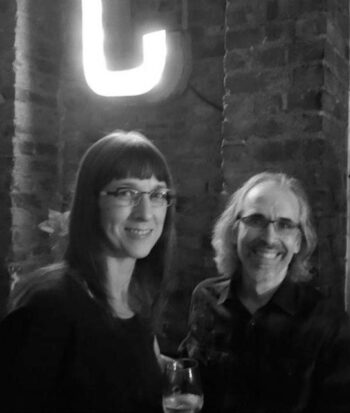
The New York Comics & Picture-Story Symposium is a weekly forum for discussing the tradition and future of text/image work. Open to the public, it meets Monday nights at 7-9pm EST in New York City. Presentations vary weekly and include everything from historical topics and technical demonstrations to creators presenting their work. Check out upcoming meetings here.
This past April, I sat down with R. Sikoryak and Kriota Willberg in their home to talk about their work. R. Sikoryak is a cartoonist, illustrator, and educator; his book Masterpiece Comics (D&Q 2009) collects some of his best-loved comics/literature adaptation parodies. He also organizes Carousel, a series of live-performance comics readings. Kriota Willberg is an expert in “body sciences,” and is an artist, dancer, choreographer, massage therapist, and anatomy teacher.
Andrea Tsurumi for The Rumpus: I wanted to talk to you guys about how you use humor and parody. You both are very funny in interesting ways. [Bob’s work] makes me look at Dostoyevsky differently and it makes me look at the comics differently. Like “Mac Worth”: it’s funny because Banquo’s sitting at a table with lots of knives in him; it’s hilarious but it also makes Mary Worth’s world seem much more terrifying. She’s really chilly and everyone’s always wearing a suit; it’s really terrifying actually.
R. Sikoryak: That’s good, that’s interesting. Mary Worth was an early strip. Looking back at it, I did use a lot of blood in that one. I mean, there’s a lot of blood in Macbeth, so it’s not out of the ordinary, but I feel like I did push it farther. I was trying to make sure that it got over the hurdle . . . is that one more severe than others? I don’t know. There’s a lot of death in my strips.
Rumpus: There’s a lot of death in the literature you’re adapting.
Sikoryak: But those are the ones I tend to be interested in.
Kriota Willberg: I think it matches Dennis the Menace. “The Menace of Denmark”… you put in a lot of gore.
Sikoryak: …I’m gratified that it makes you look at Mary Worth differently because I guess when I started this, I felt what I was trying to do was make people realize that comics could be deep. I stopped myself in the middle of saying that because the Bazooka Joe thing I do with Dante’s Inferno, that was just a goof. I wasn’t trying to make people look at Bazooka Joe more seriously. But in my mind it’s always been important.
Rumpus: Could you talk about why you chose the literature that you chose?
Sikoryak: Well, I’m drawn to stuff that is darker. I will probably do a version of Jane Austen at some point because her books are really well known. Unfortunately they’ve been parodied to death, but they’re so well known that I feel like I should approach it and I think I have an idea that will definitely spin it in a different way. There’s melancholy and sadness around the edges. I haven’t read all of her books, but it seems they often have… essentially happy endings?
Rumpus: They’re very dark…
Sikoryak: Even the endings, you feel?
Rumpus: Not the endings, but it’s mostly about money.
Sikoryak:Yeah, it’s desperation. The characters have desperation and it doesn’t work out for everyone. Maybe it’s not fair because I’m responding to the adaptations that smooth out the edges.
Willberg: You know, how this serves humor is that you create these scenarios that can be deeply disturbing, but then you see them out to the end, and you look for opportunities for humor within that context.
Sikoryak: That’s true.
Willberg: So you’re talking about Austen now. You’re thinking about Austen and then you’re thinking about who you would combine Austen with (which we won’t reveal) but . . . do you want to talk about [committing to your process? Because I think those are the choices that create the humorous scenario.
Sikoryak: Yeah that’s true, but I think I tend to . . . try to offset the drama of the literary material with people’s perceptions of the comics. So what [Andrea] said about Mary Worth was interesting because your perception of that comic is it’s a very straight-laced formal world and it is. I guess I try to find the humor by juxtaposing deeper themes in literature with what people perceive as being lighter, disposable children’s fare in comics. I just did a version of Great Expectations, and that book sort of has a happy ending. There’s a lot of melancholy in it and a lot of bad decisions and the character undergoes a deep transformation, but they shoehorned a happy ending into it so it all works out. I wonder if anyone reads the original ending… at the very end of the original version that was serialized (spoiler alert), Pip sees Estella on the street and it’s clear she’s got her own life and they’re never gonna get together and, well, that’s the way it is. In the revised version: they meet and there’s this sense that they might reconnect and there’s a hopeful…
Rumpus: Is this the movie you’re talking about?
Sikoryak: No, oh god, the movie is a whole other problem. No, in the last 5 pages of the book they meet and they talk and one of them says, “I hope we will stay friends and not be separated again.” It’s inching towards a Hollywood ending, but it doesn’t quite get there. The 1940’s movie, which I love, has this crazy ending; it goes off the rails. It’s completely melodramatic and overblown. The movie’s great up to that point, and then suddenly it stops feeling like Dickens to me. But anyway, all this was to say that I did a version of that in the style of the Charles Atlas comic advertisement, which are about as reductive as possible. I was still feeling that, as literature goes, it’s not as dark as I would’ve liked, but I’m happy (with the result. I felt like the stories paralleled each other in ways that were really interesting . Ideally, the humor comes from just putting the things together. I certainly push it sometimes, and if I’m parodying a strip that’s supposed to be funny, then I certainly try to write jokes that fit the style of the comic I’m doing, but it’s a very distanced kind of humor in some ways. I’m trying to let the subject matter and the source materials do the heavy work.
Rumpus: You’re so faithful to the text of both things too—you’re not drawing Peanuts and putting a lot of “good grief” gags in it; it’s actually Peanuts and it’s actually Kafka.
Sikoryak: That strip, Good Ol’ Gregor Brown, was the first one I did where I thought, “wow this is really the same character.” I felt there was a lot of overlap between the characters of Gregor Samsa and Charlie Brown. That’s the strip everyone remembers of mine and I think it’s because I hit upon the perfect combination. These ideas are in the air. I feel I can execute them really well, but those things exist beyond me . . . you were saying something about the comedy, or the way I write the jokes?
Rumpus: It’s interesting how your humor is working for you. You talked about how the humor brings points about both worlds that you want to show. It’s funny and it’s extremely observational (correct me if I’m wrong) but a lot of it seems to be about pointing out how weird human behavior is. Mary Worth totally could kill someone. I never thought about it before, but it makes sense.
Sikoryak: I’m such a product of my media diet… it’s interesting that you say what I do is observational. It’s observational as far as it goes—to the extent that I observe media closely. Kriota might have a better sense of this. I don’t always have the best sense of how human nature works, but I certainly know how to dismantle representations of characters (laughs).
Willberg: Humor, like drama, is setting someone on an inevitable path where they are forced to act as they act. They’re on this doomed trajectory and that’s where it gets funny. I think you’re very good at understanding the characters you’re blending: the comic character and the literature character and finding those combinations that put those characters on those inevitable paths. To behave as they would in this scenario… combining that with the way you have to paraphrase… sometimes those reductions also make things very funny.
Sikoryak: That’s definitely true in the Great Expectations strip, which is just so compressed. I do think the compression can make things very funny. It definitely can make things less dramatic. I like those kinds of comics too, where a lot of information is compressed. There are some really dark Peanuts strips and they’re only 4 panels long. One of my favorite Peanuts strips is the one where it’s snowing outside and Linus is running around saying, “It’s happening! It’s happening!” and Charlie Brown says, “What are you talking about? It’s snowing.” Linus says, “Oh, I thought it was the fallout,” or something like that. It’s the 60s! He actually uses the term “fallout.” I read it when I was 8. Huh, this got in newspapers? He would have had so many cancellations if he tried to do that in the 90s, honestly… The fact that you could say all these things, that you could make a joke about nuclear war in a Sunday newspaper strip… is pretty impressive.
Willberg: I do the same thing. I set up a scenario. Lately I’ve been getting into historical [subjects]. I love history, I love research, and I’ve just been finding absolutely outrageous scenarios that have already taken place, like operations for bladder stones in the 18th century that are just horrific. No hygiene, no anesthetic. (laughs) I’m laughing because we have all the comforts of anesthesia and no one really gets bladder stones anymore, so we can laugh from a place of safety and complete ignorance. What I do is elaboration. Adding detail and additional explanation is the thing that works humor in my pieces. So there’s that inevitable, ridiculous scenario, but the addition of the detail, the stuff that people may assume they know but they don’t really know is what’s really important to driving the thing… And making myself look like an idiot [is important], by analyzing the humor.
Rumpus: This is Pathology Laffs?
Willberg: Yeah.
Rumpus: And your Cinematologist blog (blog looking at body science in popular movies) too…
Willberg: It’s all about keeping the audience the expert, even when you’re trying to clarify and educate them because no one wants to be told that they know nothing. Instead, I say “as we all know,” or “you know a lot and here’s more…” that kind of thing. I think I find a way to make myself look frivolous or ridiculous in the Cinematologist and Pathology Laffs, which keeps everybody equal. That’s the contrast [between us]: he’s reducing, really trying to concentrate, and I’m trying to draw out all these elaborate details. I say, “bladder stone surgery,” and you cringe, then I describe how the cuts are made or how this is done and that the person is tied up and then you know more. That makes a difference within the context; adding that detail. You cringe once, then you cringe again, then you cringe again and it becomes something.
Rumpus: You both seem excited by the idea of research and detail… maybe it’s just being nerdy, but you guys have always been that way?
Sikoryak: I think one thing that probably helped us both get together in the first place was that Kriota grew up spending a lot of time in the library, and she read a lot of the comics I was into. Sensibility-wise, she had a lot of parallels with me, and even when she was doing other kinds of art, there was always a lot of research, there were great attempts to make the work very distinct from other people’s work. [Kriota] came from a background where you could’ve done more improvisational work as a dancer but you always tried to avoid making work that looked like other people’s work. One way of doing that was doing research and approaching things from different angles.
Willberg: When you try to load information into a dance piece, it’s problematic (laughs). I do that. I load the scenarios, as does Bob. I mean, I think we do it in slightly different ways, but that we’re trying to heap as much knowledge as possible into the work is something we have in common.
Sikoryak:Maybe I’m self conscious about the holes in my education so I feel a need to bolster my comics by doing lots of research…
Willberg: Did you get my sandwich?
Sikoryak: (looks) I have no idea. (Both examine their sandwiches.)
Willberg: No, that looks like mayo, never mind.
Sikoryak: We differ in our use of mayonnaise.
Willberg: Irreconcilable.
Sikoryak: I do try to compress a lot of information into what I do. It’s funny, I said something about Kriota’s work that I think has something to do with mine (that’s why it struck me)—[Kriota] always said… A lot of people in the dance world and the theater collaborate and their work can look similar, because they’re all using ideas that they either developed themselves on many pieces that they’re working on, or they pick up things from other people and they—
Willberg: And they’re all working with the same pool of dancers and they’re having the dancers develop material in the studio. Then that dancer goes to another rehearsal and develops “original” material for another choreographer. Because it’s the same dancer, you have a lot of similarity there. And I think Bob and I are both not interested in having… that “collaborative” look in the work.
Sikoryak: I used to be concerned about style, worried about my work looking like a bad copy of someone who’s better than me. So my embracing of the research and finding a way to replicate something consciously rather than replicate something unconsciously seemed like a way to go to distinguish what I do—you know what I mean? But lots of people do parody now. The whole mash-up thing that’s so prevalent now was starting in the 80’s when I was starting to think about this stuff. I certainly wasn’t the first person to do it but now… comics mash-ups, all kinds of mash-ups are everywhere.
I got this wonderful videotape that someone sent us when I worked at RAW magazine. The videotape was the audio track of Apocalypse Now dubbed over Winnie the Pooh cartoons. Apocalypse Pooh. Exactly the kind of thing I was doing, but with videotape. Also with really crude technology—I loved that so much. I can’t remember if I gave a copy to Kim’s Video… but it was the kind of work that felt very much of-the-moment, and now that is all over YouTube. So while I’m not stylistically impersonating contemporary artists, certainly my aesthetic choices have some overlap. It’s part of what’s happening now.
Rumpus: I want to ask you about your lives as artists or your lives as creative people because it’s really interesting that you’re into lots of different things. Do you find the things bleed into each other, do you keep them separate… are you just people with a lot of curiosity and are interested in a lot of things?
Sikoryak: Some of it’s desperation, in terms of where the money comes from, but it’s not only that. Speaking for myself, but [Kriota] probably [agrees], I don’t do different things because I have to, but certainly my career’s taken a lot of twists and turns because things work out for a while and then something shifts and they don’t. I went into illustration as a way of supporting my comics career. Then I got really interested in performance and I knew that was always going to be more of a hobby, but that’s something I’ve kept doing. I would like to keep doing that in some capacity. Now I’m doing more animation work. That’s something I really wanted to do in the 80’s. The technology, or I should say, the craft of it wasn’t as well known to me as it is now. I’ve gotten the opportunity to work in animation based on people seeing what I could do in my comics and realizing that it could be transposed to that medium. I’m really grateful that it’s happened, because I was interested in it. But comics, animation, even theater… they all overlap in a lot of ways: from the way comics tell stories to the way they look. There’s lots of crossover, so I’m not sure what you had in mind in terms of the different things I do but…
Willberg: We’ve been together for almost 20 years now and 20 years ago, and even before that, you had a broad variety of interests. You would be at Parsons doing performance in the cafeteria while you were getting an illustration degree and taking cartooning classes at another school—
Sikoryak:At SVA.
Willberg: So you started with a broad base and then as you continued forward in time, it started to consolidate as an organized stream. For me, I was dancing and if I could’ve just danced, I would’ve done that. But it wasn’t a possibility because the money isn’t there, so I pursued other areas. Not necessarily out of interest other than financial, but out of necessity. But then what happened for me was that my bases narrowed. I quit dance about 6 years ago. It was like “Yeehaw! I’m going to have an artistic career that feeds into my (body sciences) day job where the research I do isn’t superficial!” Now, I’m researching bladder stones in the 18th century, but at the same time I get to buff up on kidney disease (I guess that’s useful somehow in the rest of my life) Now I’m more focused than I’ve ever been which… it’s still not insanely focused.
Rumpus: But you see a pattern.
Willberg: I see a pattern: I’m narrowing down. He’s kind of staying on a parallel track or even broadening out.
Sikoryak: I see your different works having similar content, but I don’t see the forms being the same.
Willberg: OK, yeah, I’ll take that. I wasn’t making dances with medical themes, well some of them, but you know… by getting out of dance, I feel like I’ve pulled in, which is good.
Rumpus: Can you talk a bit about your needlework?
Willberg: Sure. I translate medical technical imagery into embroidery and needlepoint. It’s all really portraiture because the source material, MRIs, ultrasounds, oscopies, and whatever they are, they’re either my own or those of friends or of people I know who gave them to me. I’m not just downloading images from the Internet and then replicating some stranger’s body. I’m actually showing you a portrait of my friend or someone connected to me. Even in this context, I’m interested in the history of medicine, of needlework, of stitches, and the development of the Sampler, so again, I’m loading [research]. It can’t be helped (laughs). It’s funny because when I first started doing it I said that I was going to do this as a hobby. Every hobby I have turns into a professional pursuit. Essentially, at this point, if I have to label myself with one term, I just say I’m a “Body Science Artist” because of the multidisciplinary or multimedia aspect of what I do.
Rumpus: Is that your brain (cross-stitch/embroidery) hanging over the TV?
Willberg: That is my brain (laughs) surrounded by a border of interneurons.
Rumpus: I love your “titty twister” from Pathology Laffs.
Willberg: (laughs) I spent my weekend in a “massage for breast cancer patients” workshop, and we were literally studying breasts all day and then we had our hands on breasts and we’d talk about cancer, and everything looked like a boob by the end of the day. So I came up with a bunch of different scenarios and I made the titty twister. It’s not really medical, but it came about from that.
The Rumpus: And on the Cinematologist, I love that you got preoccupied by whether or not this wounded character’s pants leg stays on in Lockout.
Willberg: During an emergency situation, I guess you just need to stop bleeding and that’s enough; you don’t have to worry about infection until you get back to Earth.
Rumpus: So performance is something that’s important to both of you. Can you talk a little about that? Is Carousel primarily how you’re doing performance now?
Sikoryak: Yeah, we used to collaborate on shows. I would do scenery and projections for dance pieces and theater pieces that Kriota would conceive and choreograph—
Willberg: Sometimes he would do live drawing.
Sikoryak: These were shows we conceived with a good friend of ours, the writer Todd Alcott, so whatever we wanted to do got into the show. It wasn’t really hard for us— it was a matter of one of us saying, “well I want to do this!” and then we’d all figure out a way to work it in. Besides creating slide shows for Carousel, I’d love to do more live drawing or painting performances. I’ll start with a big empty canvas onstage, and I’ll begin to do a fast action painting which it seems very abstract, but by the end of it, 5 minutes later, it evolves into a figurative image. There’s something about watching people draw [that] can be really exciting. I like the theatricality of it if you do it well. When I do it, I plan them out so they look spontaneous, but I know where I’m going. Hopefully it’s a bit of a magic act, so the audience can’t see what it is and then suddenly there’s a reveal. Sometimes I’ve seen people draw more casually on stage, and I’ve missed the element of surprise. It’s still fun to watch, but it doesn’t have the drama that I’m going for.
Carousel is my main performance outlet. I was first inspired to do cartoon slide shows when I saw Roz Chast read her gag cartoons to a big audience around 1991. It was very exciting to see her onstage next to her images. She was a little nervous at first, in a big auditorium and the images were huge. As an average sized person, she looked very tiny next to those big scribbly drawings. You instantly saw the connection between her and the drawings. All the elements combined to create the sense of a personality. I liked that live aspect too, which is obviously something that’d be missed in an animated version of her gag cartoons.
Very often, if the person who wrote the cartoon doesn’t read the cartoon [aloud]—it’s missing something great. It doesn’t have that wonderful dynamic of the artist in front of the art. Again, I like the drama or at least the comparison that you get with having the person there. That really inspired me to start reading my comics [aloud], and then I found other artists and performers who were doing slideshows, and the Carousel show grew. Now, with PowerPoint it’s relatively easy and very cheap to convert your work into shows. Making it interesting as a performance can still be hard. For instance, some artists try to show their whole pages on the screen, which can be really boring.
KW: Bob’s background in performance and theater means he understands what goes into a good show. If he’s doing a Carousel, he will give guidelines to artists who haven’t done it before, suggestions about what will make this more interesting to audiences. Sometimes they don’t do it, often they do. With Carousel, I think that gives the audience the expectation that they’re going to have a good show. Bob really understands theatrical magic so he can relate quite easily to how people work that out…
Sikoryak: I’m not a director by any means, but I will give people feedback. I guess it’s more like being an editor than being a director because for the most part, it’s more like general guidelines. I love a good editor; it helps to have a set of eyes that knows what they want. I’m certainly not dictatorial, but I do see a lot of people do presentations and I can see what works. And I do try to scout around. Robyn Chapman just had a great show at KGB. I hadn’t seen half of those artists before, and they were all really good… Everyone’s getting better at it—everyone’s seen someone do a cartoon slideshow at this point, at least in our circuit. So it’s easier for people to see what works. Just like in comics, the quality’s generally going up, because when I started it was harder. I used a classic Kodak Carousel slide projector. You’d have to make 35mm slides and take photos… unless you drew on acetate and projected that. Once, I saw this very funny slide show—I can’t even remember the name of the artist, but they were projecting their work and the artist was on stage. This artist was so shy—their voice was really, really soft and barely audible through the microphone. I don’t know if you know Andy Kaufman, but it was almost a Kaufman-esque anti-theater piece because you could barely hear what they were saying and… it was fascinating! Sometimes I love seeing art where everything goes wrong—perhaps there’s a way to do that and make it part of the piece, but that artist wasn’t there yet. Anyway.
Tony Millionaire did a slide show years ago that was just great, but I don’t want to go into all of the highlights. Tony Millionaire is really a—
Willberg: Showman.
Sikoryak: Showman, yeah, he did something really funny.
Willberg: You know, he’s a natural. Not everybody’s a natural.
Sikoryak: It’s hard to do that. I know I get nervous.
Sikoryak: And even with Roz Chast, I sensed some nervousness when she started, but as the crowd responded, she seemed to warm up and get very comfortable onstage. It was not premeditated, but it was genuinely great to see that happen.
Willberg: In the performative relationships with the people onstage, you know as a performer if you’re comfortable there. It’s a lot of fun and you really feel like you have a psychic conversation with your audience. [How they interpret you] is totally beyond your control, but I do think that if you feel the audience responding, then it does allow you to give even more.
Rumpus: More immediate than when you make comics?
Willberg: When we were teaching at the Center for Cartoon Studies and I was conferencing with my students, I’d ask them, “Who’s your audience for this? Do you know?” Some of them didn’t and some of them did. Some of them thought they were targeting certain audiences and I wasn’t quite convinced. But you know, who knows? And some people know exactly… It was really interesting to see how people perceive the reception of what they’re doing, or who it is for.
Sikoryak: I want to respond to what you just said about it being performative…? You mean as a reader?
Rumpus: Ah, I mean storytelling is performative: you’re using tools you would use in a live performance, but you’re in private, removed from a direct audience. Pacing, timing, characterization, suspense, dramatic irony, all that stuff and… it’s still a kind of communication, but a different breed from what live performance is. Sitting at home drawing and putting work out there is putting it out there, it’s not like a… Darger situation or something (laughs) anyway, digression, but it’s an interesting thing…
Willberg: When I was trying to figure out Pathology Laffs, this was a real issue because if I just write a gag cartoon about phagocytosis, it’s only going to be understood by two people in the whole world. That’s an exaggeration, but it’s really specialized material and who’s gonna get it? For years, I would be telling Bob gag jokes that he wouldn’t get. Then I’d have to explain it, and so then he said, well you should do that.
Sikoryak: For Carousel.
Willberg: For Carousel, and so that’s how Pathology Laffs started and because I have a performance background and I teach, its easy to do that… Where was I going with that? Or did I get there?
Sikoryak: You said something else that I wanted to ask about. Kriota was talking about asking students who their audience was. And I hear so many people say this, and I think it’s legitimate: “I make my work for myself. I am my audience.” I hear professionals say that… all kinds of people. You know, even Chuck Jones said that about the Bugs Bunny cartoons, “We weren’t making these for kids, we were making them for ourselves.” If you’re really talented, you can do that sometimes and still reach a big audience. If you’re not, then you make it for a small group of like-minded people, and that’s fine.
But Kriota and I are both very conscious of an audience whether it’s in the room or it’s readers down the line. And the reason I started doing parodies was I wanted to make comics that people who didn’t read comics could at least look at and say, “OK, I know how to approach a comic that looks like Peanuts.” I was trying to find a way in for people who wouldn’t necessarily read the kind of avant-garde or mature comics that I was interested in. How could I get those people to want to read my stuff? Working in a style that’s familiar is a way to break down barriers and let people in a little bit. I’m sure it discourages people too, I mean, if you don’t like Batman comics, you’re probably not going to want to read “Dostoyevsky Comics,” but if you give me the benefit of the doubt, then maybe it’s successful.
Rumpus: Do you get any feedback on that from your readers?
Sikoryak: A website called Again with the Comics posted “Dostoyevsky Comics” on his site after it went out of print. (This was before it was reprinted in Masterpiece Comics.) Which was great, we got a lot of notice for it. All of these Russian Literature fans wrote in complaining about “stupid Americans… this is the problem with America: the way you destroy literature and art…” (laughs) They did not get it. I guess that shouldn’t surprise me… I think what’s interesting and inevitable is when you make work, it’s always a product of the era it’s made in. Kriota and I talk about this all the time, I’ve tried to get around that by working with sources that are bigger and more timeless, like Peanuts. It’s been gone for a decade, but people still know of it. So much of what I do and so much of the styles I choose to work with are really particular to an era.
KW: And your impulse. Your creative impulse is also based in your time. Even though you’re doing these mash-ups, which you know were big in the late 80’s and early 90’s, the moment you make any original work, it’s history, literally. And it’s dated. There’s nothing you can do about it. And then you have to hope that it has legs for 20 years, 50 years, whatever, because some things just don’t, and then you’re out of luck. You have to watch and see what happens, how it’s interpreted later.
Sikoryak: I actually did have that luck, because there was a resurgence of this kind of work when my book finally came out; plus it was easier to make these things.
Willberg: And people understood them better.
Sikoryak: Saturday Night Live has been on for over thirty-five years, all the parodies they’ve been doing still speak to an audience. Mad Magazine is still going, it still speaks to an audience.
Willberg: And Mad used to be a totally original, different concept that no one had ever seen before and now it’s this chestnut. And it’s not its fault.
Rumpus: It’s just been good for too long.
KW: Like those adorable punkers. At one time they were really disturbing to a lot of people and now we think about them fondly because they’re people’s parents.
Sikoryak: A friend of ours was telling us he was in a record store with someone who was a little younger than him, and a N.W.A. song came on, I’m assuming it was Fuck the Police, and she said [fondly], “Aw! I remember this song! That takes me back.” This shocking song had become a piece of nostalgia to a young white woman.
Willberg: What I’m doing now is also totally a product of its time. Fortunately, or unfortunately for me, I realized: I can make work about medical technology, body sciences, whatever. We’re at a time when everybody else is coming to the same conclusion. The whole art/science blend… there are a number of different avenues of that, but even so, it’ll become a dated product. Even if it’s a new product, it’ll quickly become a dated product, you can’t get over it.
Sikoryak: Well, it’s not a bad thing to be making work that other people can understand.
Willberg: (laughs) It’s true, there are benefits, and some people have long ripe careers and their stuff is always great, and some… well, they’ll have some hits and some misses and you just have to wait and see. That’s part of what’s actually exciting for us. I think it also makes us figure out why we’re doing what we’re doing because you know it could bomb massively or just be totally lost within the context of all the other artwork, whatever it is.
Rumpus: So why are you doing this?
Willberg: Because I enjoy it and I have this compulsion to make stuff. And for me, because I’ve been a professional artist all my adult life, making stuff without trying to pursue some peer environment just doesn’t seem natural. Although, I have a collection of woven baskets I could show you (laughs). That’s not true. But I think, and this is probably true for [R. Sikoryak] too, at this point, producing creative products also goes hand in hand with the marketing of that product. I don’t think of the process as stopping with making the thing, because part of that process is finding a way to promote it, distribute it, or move it beyond this apartment.
Sikoryak: Part of that impulse comes from the fact that we grew up in an era when it was much harder to get a comic published than it is now. It blows my mind how many people are making long form color comics now. Previously, unless you were drawing Superman stories or a Sunday comic strip in a thousand newspapers, you weren’t likely to have color or space. I’ve always thought of my work as being made for reproduction and for an audience. It’s not painting, it’s meant to be distributed. That’s a big part of ‘who is it for?’ If you’re smart, you’re thinking about that. Darger was not. He didn’t tell anybody, or nobody listened to him. He definitely didn’t have a good agent (laughs).
Rumpus: He didn’t have many friends. Or it was partly just poverty.
Sikoryak: Right.
Rumpus: To end it on that note! (laughs)
Willberg: He’s doing better than we are (laughs).
Sikoryak: God bless him, but certainly he was lucky that someone found his artwork. Even though it’s all been dismantled and sold without him profiting in any way whatsoever… I still have students who respond deeply to his work. It’s really potent and immediate. While definitely being a product of its own era too.
Willberg: Even with outsider art, you can look at it from different decades, and you can tell when it was made, the 1930s… the 1960s…
Rumpus: Like Dada seems kinda… brown? In a weird way…
Willberg: Forms that we would make out of plastic are wood or organic materials.
Rumpus: But that’s the hope right? You don’t know if you’re gonna survive or if it’s gonna get out there, but you just have to make it, right?
Sikoryak: …Or if computers will be able to read the format that you created it in. (laughs).
Rumpus: Betamax!
Sikoryak: And video games! I was just reading about a place that archives machines that can play video games that would be lost otherwise. I don’t know if they could be replicated in a new format… or if anyone has the money or will to do that. The struggle to keep these games around so we can look at them is pretty wild.
Willberg: We’re both drawing on the computer all the time now. That titty twister gag is totally dependent on code. So no one can sift through my archives and find a lot of my work. They have to sift through my hard drive. That’s another thing.
Rumpus: Or maybe the aliens will find titty twister.
Willberg: That would be really funny. And you know, global warming, that’s why they disappeared.
Rumpus: And you know, eventually the sun will explode.
Willberg: And then time will stop and…
Rumpus: And the end of the end of the end of the end (laughs).
Willberg: Way better than ending with Henry Darger.
***
Image Credits:
Image 1: (Augenblick Studios photo), Kriota Willberg & R. Sikoryak, photo.
Image 2: R. Sikoryak, “Mac Worth”, Masterpiece Comics, 2009
Image 3: R. Sikoryak, “The Expectations That Made a Gentleman Out of ‘Pip,’” Devastator issue 8, 2013.
Image 4: R. Sikoryak, “Good Ol’ Gregor Brown,” Masterpiece Comics, 2009
Image 5: K. Willberg, Pictorial Anatomy of the Cute, 2013
Image 6: (Donna Almendrala photo). K. Willberg performing Pathology Laffs at MECAF Carousel, 2012
Image 7: K. Willberg, The Inspiration of Marin Marais, 2013
Image 8: K. Willberg, Lisa Fetus 2A (Embroidery on Linen), 2011
Image 9: K. Willberg, Root Canal (Needlepoint), 2012
Image 10: K. Willberg, “Titty Twister,” Pathology Laffs, 2012
Image 11: (The Moon Show photo), R. Sikoryak & Kriota Willberg performing Action Camus! At The Moon Show, 2012
Image 12: (Dre Grigoropol photo), M. Sweeney Lawless, James Godwin, and R. Sikoryak reading “The Crypt of Bronte” at Carousel, Dixon Place, Feb. 2013
Image 13: (Kevin Maher photo), R. Sikoryak finishes a live drawing (projected via tabletop camera) at a Carousel for Kids show at Dixon Place, Nov. 2012
Image 14: R. Sikoryak, Carousel poster, 2011
Image 15: R. Sikoryak, “Dostoyevsky Comics,” Masterpiece Comics, 2009
R. Sikoryak, “Action Camus,” Masterpiece Comics, 2009
R. Sikoryak, “The Crypt of Brönte,” Masterpiece Comics, 2009
Image 16: K. Willberg, (No) Pain mini, 2012
***
About the author: Andrea Tsurumi is an illustrator and cartoonist who likes her history dark and funny. You can see her work here and check out her latest projects here. She lives in Astoria, NY.




